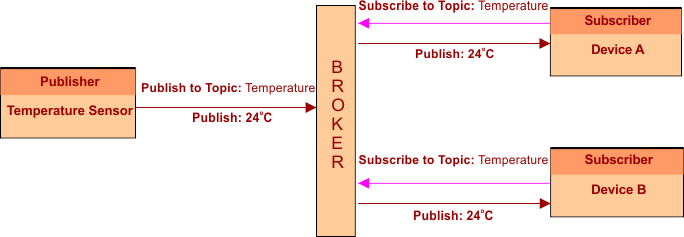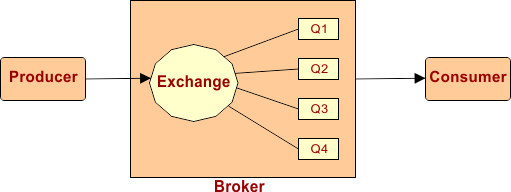Internet of Things (IoT) Protocols
IoT is the name for various things that are interconnected with each other. The communication between these things happens through different protocols or standards, called IoT Protocols and standards.
There are a lot of protocols and standards, But we will discuss the most popular standards.
1. MQTT Protocol
MQTT stands for Message Queue Telemetry Transport. It is a Publisher-Subscriber model based on a lightweight protocol. It sends simple data from the publisher (sensors) to the subscriber (applications) through middleware (Broker).

- MQTT has three essential components: subscriber, publisher, and broker.
- MQTT is mainly used in small, low-memory, low-power, and cheap devices.
Example: If it needs to sense the temperature, the sensor senses the data and sends it to the broker. The broker forwards this temperature to those devices that subscribe to the topic temperature.
2. DDS Protocol
DDS stands for Data Distribution Service. It is an IoT protocol for real-time and high-performance machine-to-machine communication.
You can use DDS in low-footprint (sensors) devices and the cloud (server). The DDS protocols have two main layers
- Data-Centric Publish-Subscribe (DCPS): It delivers the information to subscribers
- Data-Local Reconstruction Layer (DLRL): It provides an interface to DCPS functionalities
3. AMQP Protocol
AMQP stands for Advanced Message Queuing Protocol. It is an application layer protocol for message-oriented middleware environments and is approved as an international standard.

The following terms can help to explain it more clearly:
- Exchange: it gets messages from the publisher and puts them into message queues
- Message queue: it stores messages that the publisher sends. And then later on forward to clients
- Binding: it is a link that exists between exchange and queue. It states the relationship between the first and the second components.
- Subscriber: It consumes the services of a publisher.
4. Bluetooth Protocol
Bluetooth is a short-range communications technology. It is mainly found in smartphones and mobile devices. With the help of IOT protocols, the new application appeared with Bluetooth Low-Energy (BLE) or Bluetooth Smart. This technology is scalable, flexible, and consumes less power than all market innovations.
- Standard: Bluetooth 4.2
- Frequency: 2.4GHz
- Range: 50-150m (Smart/BLE)
- Data Rates: 1Mbps (Smart/BLE)
5. Wi-Fi Protocol
Wi-Fi is used in radio wireless networking of devices. It can process large amounts of data and transfer it quickly.
This type of connectivity is mostly found in LAN environments.
- Standard: Based on IEEE 802.11
- Frequencies: 2.4GHz and 5GHz bands
- Range: Approximately 50m
- Data Rates: 150-200Mbps, 600 Mbps maximum
6. Zigbee Protocol
ZigBee is a low-power, low-data-rate wireless network. It is mainly used in industrial settings. The Zigbee community created the universal language for IoT called Dotdot. Dotdot is used in smart objects to work securely on any network.
- Standard: ZigBee 3.0 based on IEEE802.15.4
- Frequency: 2.4GHz
- Range: 10-100m
- Data Rates: 250kbps
7. Cellular Protocol
Cellular Technology is used in mobile phone networks. But it is also used in IoT applications and can transfer data for long distances. IoT can take advantage of cellular communication technology by using its capabilities (I.e., GSM (Global System for Mobiles 2G), 3G, 4G, and 5G).
It can transfer a more significant amount of data, but the power consumption and the expenses are high.
- Standard: GSM/GPRS/EDGE (2G), UMTS/HSPA (3G), LTE (4G)
- Frequencies: 900/1800/1900/2100MHz
- Range: 35km (GSM); 200km (HSPA)
- Data Rates: 35-170kps in GPRS, 120-384kbps in EDGE, 384Kbps-2Mbps in UMTS, 600kbps-10Mbps in HSPA, and 3-10Mbps in LTE 4G.
8. LoRaWAN
LoRaWAN stands for Long Range Wide Area Network. It is a protocol for wide-area networks (WAN). It is designed for massive networks (e.g., smart cities) with millions of low-power devices.
LoRaWAN is a secure bidirectional communication in various industries. It can provide low-cost mobile as well.
- Standard: LoRaWAN
- Frequency: Various
- Range: 2-5km (urban area), 15km (suburban area)
- Data Rates: 0.3-50 kbps













